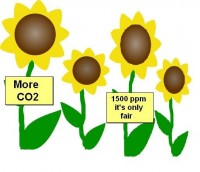By Chip Knappenberger
Editor Note: Using mainstream models and assumptions, Mr. Knappenberger finds that in the year 2050 with a 83% emissions reduction (the aspirational goal of Waxman-Markey, the beginning steps of which are under vigorous debate), the temperature reduction is nine hundredths of one degree Fahrenheit, or two years of avoided warming. A more realistic climate bill would be a fraction of this amount. The author will respond to technical questions on methodology and results and invites input on alternative scenarios and analyses.
“A full implementation and adherence to the long-run emissions restrictions provisions described by the Waxman-Markey Climate Bill would result only in setting back the projected rise in global temperatures by a few years - a scientifically meaningless prospect.” The economics and the regulatory burdens of climate change bills are forever being analyzed, but the bills’ primary function- mitigating future climate change - is generally ignored. Perhaps that’s because it is simply assumed.
After all, we are barraged daily with the horrors of what the climate will become if we don]t stop emitting greenhouse gases into the atmosphere (the primary focus being on emissions from the combustion of fossil fuels). So doing something as drastic as that proposed by Waxman-Markey - a more than 80% reduction of greenhouse gas emissions from the United States by the year 2050 - must surely lessen the chances of climate catastrophe. Mustn’t it?
But if that were the case, why aren’t the climate impacts being touted? Why aren’t Representatives Waxman and Markey waving around the projected climate success of their bill? Why aren’t they saying: “Economics and regulations be damned. Look how our bill is going to save the earth from human-caused climate apocalypse”?
That reason is that it won’t. And they know it. That is why they, and everyone else who supports such measures, are mum about the outcome. The one thing, above all others, that they don’t want you to know is this: No matter how the economic and regulatory issues shake out, the bill will have virtually no impact on the future course of the earth’s climate. And this is even in its current “pure” form, without the inevitable watering down to come. So discussion of the bill, instead of focusing on climate impacts, is shrouded in economics and climate alarm.
However, in absolutely zero of these cases are you told, or can you calculate, how much impact you are going to have on the actual climate itself. After all, CO2 emissions are not climate - they are gases. Climate is temperature and precipitation and storms and winds, etc. If the goal of the actions is to prevent global warming, then you shouldn’t really care a hoot about the amount of CO2 emissions that you are reducing, but instead, you want to know how much of the planet you are saving. How much anthropogenic climate change is being prevented by unplugging your cell phone charger, from biking to the park, or from slashing national carbon dioxide emissions?
By the year 2050, the Waxman-Markey Climate Bill would result in a global temperature “savings” of about 0.05C regardless of the IPCC scenario used - this is equivalent to about 2 years’ worth of warming. By the year 2100, the emissions pathways become clearly distinguishable, and so to do the impacts of Waxman-Markey. Read much more here and here and here.
By Joseph D’Aleo
The Proposed Endangerment and Cause or Contribute Findings for Greenhouse Gases under the Clean Air Act was signed on April 17, 2009. On April 24, 2009, the proposed rule was published in the Federal Register under Docket ID No. EPA-HQ-OAR-2009-0171: Proposed Endangerment and Cause or Contribute Findings for Greenhouse Gases under the Clean Air Act (PDF). The notice in the Federal Register started the official 60 day clock for comments. Public comments on the proposal must be submitted to EPA by June 23, 2009.
Technical analyses developed in support of the Proposed Endangerment and Cause or Contribute Findings for Greenhouse Gases under the Clean Air Act may be found here: Technical Support Document for the Proposed Findings (PDF)
Although the “cause or contribute” aspect of the endangerment finding was limited to GHGs from new motor vehicles and engines, it is widely understood that once the proposal is finalized, EPA can proceed to other sources regulated ( powerplants, refineries, manufacturing plants) under the Clean Air Act (CAA).
Although EPA did not propose any associated regulations at this time, the endangerment finding is EPA’s first step towards triggering a cascade of CAA programs that will effectively impose strict regulations on a large segment of the American economy. This may include regulations that will affect most all buildings including churches, schools, large and small businesses, the kind of fuels used, the car you drive and, taken to the extreme, how many times you can mow your lawn or blow away your snow or whether you can burn wood in your home stove. The regulations will be just as onerous as cap and trade legislation. The public is unaware that though not a direct tax, the costs of increased regulation and or “cap-and-trade” scheme (really ration-and-tax) will likely run at least $2000 for Americans according to this conservative Heritage Foundation study up to $3100 per family per year according to an MIT study, with increased government control over your entire life, increased job losses and energy shortages. Additional economic analysis showing impacts by state can be found here.
Write your two Senators, Representative and the President, write a letter to your favorite newpaper or post on a blog discussing the EPA ruling or the government’s planned climate actions. Call in to talk radio and explain the dangers of these proposed actions and cap-and-tax legislation if congress feels pressured to act. You can use the Search ICECAP feature to find supporting info to address each one of the so called science findings which we know are wrong with evidence the fact that temperatures are cooling, sea levels are not rising, global ice is not melting, there are fewer heat waves, less drought, fewer global hurricanes and that CO2 is not a dangerous pollutant but a life giving plant fertilizer that has greatly aided agriculture. You can also address the fact that climate models are failing miserably in all these ways.
Both scientists and citizens can make comment on the EPA Endangerment Proposal and the ‘findings’ on which it is based. See the Technical Support document on which the findings were based. It is essentially extractions from the revised US CCSP and IPCC AR4 Summaries. A good selection of the comments filed on the initial CCSP report and the EPA ANPR can be found on Icecap here.
See the EPA web site for how you can submit a comment here. Instructions for filing comments can be found here. Read both documents and refer back to the referenced sections in the IPCC and CCSP. Choose an area (or areas) you feel most qualified to challenge and draft a challenge following carefully the instructions for formatting and submitting above. In your challenge, cite the section and page of the report you are challenging and where possible the quote. Wherever possible cite supporting peer review support for your challenge, including ideally in the case of publishing scientists, your own work. You can use insert topics or authors in SEARCH ICECAP or search tools in Climate Science[link],Climate Audit[link], CO2Science[link], Watts Up With That[link], World Climate Report[link], CEI[link], Heartland[link, link to NYC papers] or just Google. Feel free to contact us for suggestions or to ask about a draft comment you send us. The challenge does not need to be lengthy. Short pithy comments can be just as effective. When you submit comments please send a copy to us so we can put them into a library that is searchable and can be used as a resource in legal challenges.
In May, there will be public hearings. EPA requests those who wish to attend or give public comments, to register on-line in advance of the hearing. EPA will audio web stream both public hearings. The meeting information pages will be updated with this information as it becomes available. The hearings are scheduled at May 18, 2009, at the EPA Potomac Yard Conference Center, Arlington, VA; and May 21, 2009, at the Bell Harbor International Conference Center in Seattle, WA.
The Endangerment Finding and the Technical Support Document will become the US version of the IPCC 2007 report. If left unchallenged, there is no tomorrow. Read more here.

By Matt Dempsey, EPW
Taxpayers Face up to $11 Billion in Liability Costs
WASHINGTON, D.C. –U.S. Senator James Inhofe (R-Okla.), Ranking Member of the Senate Environment and Public Works Committee, along with sixteen of his Republicans colleagues, sent a letter today to Energy Secretary Steven Chu asking about his comment that Yucca Mountain is “not an option” for disposing nuclear waste. Specifically, in the letter, the senators raise several questions about the legal, scientific, and technical justifications for the Obama Administration’s decision to derail the Yucca Mountain project, which has been studied for decades and supported by the National Academy of Sciences and other leading scientific organizations as a viable storage site for nuclear waste.

“The Obama administration’s approach to Yucca Mountain is nothing short of puzzling,” Senator Inhofe said. “Despite President Obama’s pledge that science will guide public policy and his commitment to an unprecedented level of openness, I find it difficult to understand Secretary Chu’s statement that Yucca Mountain is ‘not an option,’ made after only six weeks in office. This comment is of particular interest considering that, as recently as August 2008, all ten National Lab directors, including Secretary Chu, signed a letter on the essential role of nuclear energy, which advocated continuing the licensing of a geologic repository at Yucca Mountain.”
“The American taxpayer has invested too much money in Yucca Mountain to simply have it be pushed aside without a full explanation. As of today over $7.7 billion has been spent researching Yucca Mountain as a potential repository site, and neither the National Academy of Sciences, the Nuclear Waste Technical Review Board, nor any of our National Labs involved in conducting studies and evaluating data have concluded that there is any evidence to disqualify Yucca Mountain as a repository. Taxpayers face up to $11 billion in liability costs if the Department of Energy begins accepting used fuel and nuclear waste in 2020 and an additional $500 million with each passing year of delay.”
See release here.


